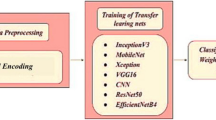Access this chapter
Tax calculation will be finalised at checkout
Purchases are for personal use only
Similar content being viewed by others
References
World Health Organization (2020) Globocan 2020. Estimated cancer incidence, mortality, and prevalence worldwide in 2020. https://gco.iarc.fr/today/data/factsheets/cancers/6-Oesophagus-fact-sheet.pdf
Dong J, Thrift AP (2017) Alcohol, smoking and risk of oesophago-gastric cancer. Best Pract Res Clin Gastroenterol 31(5):509–517
Chlosser RW (2006) The role of systematic reviews in evidence-based practice, research and development. Focus 15. https://ktdrr.org/ktlibrary/articles_pubs/ncddrwork/focus/focus15
World Health Organization (2017) More can be done to restrict sunbeds to pre- vent increasing rates of skin cancer. https://www.who.int/phe/news/sunbeds-skin-cancer/en/
NHS (2020a) How does the sun and UV cause cancer?. https://www.nhs.uk/conditions/melanoma-skin-cancer/causes/
Simonyan K, Zisserman A (2014) Very deep convolutional networks for large-scale image recognition. arXiv preprint arXiv:1409.1556
Szegedy C, Liu W, Jia Y, Sermanet P, Reed S, Anguelov D, et al. (2015) Going deeper with convolutions. In: Proceedings of the IEEE conference on computer vision and pattern recognition, p 1–9
He K, Zhang X, Ren S, Sun J (2016) Deep residual learning for image recognition. In: Proceedings of the IEEE conference on computer vision and pattern recognition, p 770–778
Chollet F (2017) Xception: deep learning with depthwise separable convolutions. In: Proceedings of the IEEE conference on computer vision and pattern recognition, p 1251–1258
Huang G, Liu Z, Van Der Maaten L, Weinberger KQ (2017) Densely connected convolutional networks. In: Proceedings of the IEEE conference on computer vision and pattern recognition, p 4700–4708
Popescu D, El-Khatib M, ElKhatib H, Ichim L (2022) New trends in melanoma detection using neural networks: a systematic review. Sensors
Shen X, Wei L, Tang S (2022) Dermoscopic image classification method using an ensemble of fine-tuned convolutional neural networks. Sensors
Esteva A, Kuprel B, Novoa RA, Ko J, Swetter SM, Blau HM et al (2017) Dermatologist-level classification of skin cancer with deep neural networks. Nature 542(7639):115–118
Kawahara J, BenTaieb A, Hamarneh G (2016) Deep features to classify skin lesions. In: 2016 IEEE 13th international symposium on biomedical imaging. IEEE, pp 1397–1400
Xie S, Girshick R, Dollár P, Tu Z, He K (2017) Aggregated residual transformations for deep neural networks. In: Proceedings of the IEEE conference on computer vision and pattern recognition, pp 1492–1500
Hu J, Shen L, Sun G (2018) Squeeze-and-excitation networks. In: Proceedings of the IEEE conference on computer vision and pattern recognition., pp 7132–7141
Ain QU, Al-Sahaf H, Xue B, Zhang M (2020) Generating knowledge-guided discriminative features using genetic programming for Melanoma detection. IEEE Trans Emerging Top Comput Intell
Mohamed EH, El-Behaidy WH (2019) Enhanced skin lesions classification using deep convolutional networks. In: 2019 Ninth international conference on intelligent computing and information systems. IEEE, pp 180–188
Steppan J, Hanke S (2021) Analysis of skin lesion images with deep learning. arXiv:2101.03814
Tschandl P, Rosendahl C, Kittler H (2018) The HAM10000 dataset, a large collection of multi-source dermatoscopic images of common pigmented skin lesions. Sci Data 5:180161
Mahbod A, Schaefer G, Wang C, Dorffner G, Ecker R, Ellinger I (2020) Transfer learning using a multi-scale and multi-network ensemble for skin lesion classification. Comput Methods Programs Biomed 105475
Sae-Lim W, Wettayaprasit W, Aiyarak P (2019) Convolutional neural networks using mobilenet for skin lesion classification. In: 2019 16th international joint conference on computer science and software engineering. IEEE, pp 242–247
Chaturvedi SS, Gupta K, Prasad PS (2020) Skin lesion analyser: an efficient seven-way multi-class skin cancer classification using MobileNet. In: International conference on advanced machine learning technologies and applications. Springer, pp 165–176
Ju L, Wang X, Wang L, Mahapatra D, Zhao X, Harandi M, Drummond T, Liu T, Ge Z (2021) Improving medical image classification with label noise using dual-uncertainty estimation. 2103.00528
Jinnai S, Yamazaki N, Hirano Y, Sugawara Y, Ohe Y, Hamamoto R (2020) The development of a skin cancer classification system for pigmented skin lesions using deep learning. Biomolecules 10(8):1123
De Hertog SA, Wensveen CA, Bastiaens MT, Kielich CJ, Berkhout MJ, Westendorp RG, Vermeer BJ, Bavinck JNB (2001) Relation between smoking and skin cancer. J Clin Oncol 19
Acosta MFJ, Tovar LYC, Garcia-Zapirain MB, Percybrooks W (2021) Melanoma diagnosis using deep learning techniques on dermatoscopic images. BMC Med Imaging 21
Hasan M, Elahi ME, Alam MA (2021) Dermoexpert: skin lesion classification using a hybrid convolutional neural network through segmentation, transfer learning, and augmentation. medRxiv
Heidari M, Mirniaharikandehei S, Khuzani AZ, Danala G, Qiu Y, Zheng B (2020) Improving the performance of CNN to predict the likelihood of COVID-19 using chest X-ray images with preprocessing algorithms. Int J Med Inf 144:104284
Mikołajczyk A, Grochowski M (2018) Data augmentation for improving deep learning in image classification problem. In: 2018 International interdisciplinary PhD workshop. IEEE, pp 117–122
Alpaydin E (2020) Introduction to machine learning. The MIT Press, Cambridge, MA, USA
Author information
Authors and Affiliations
Corresponding author
Editor information
Editors and Affiliations
Rights and permissions
Copyright information
© 2023 The Author(s), under exclusive license to Springer Nature Singapore Pte Ltd.
About this paper
Cite this paper
Nalamwar, S.R., Neduncheliyan, S. (2023). Skin Cancer Multiclass Classification Using Weighted Ensemble Model. In: Balas, V.E., Semwal, V.B., Khandare, A. (eds) Intelligent Computing and Networking. IC-ICN 2023. Lecture Notes in Networks and Systems, vol 699. Springer, Singapore. https://doi.org/10.1007/978-981-99-3177-4_12
Download citation
DOI: https://doi.org/10.1007/978-981-99-3177-4_12
Published:
Publisher Name: Springer, Singapore
Print ISBN: 978-981-99-3176-7
Online ISBN: 978-981-99-3177-4
eBook Packages: Intelligent Technologies and RoboticsIntelligent Technologies and Robotics (R0)




